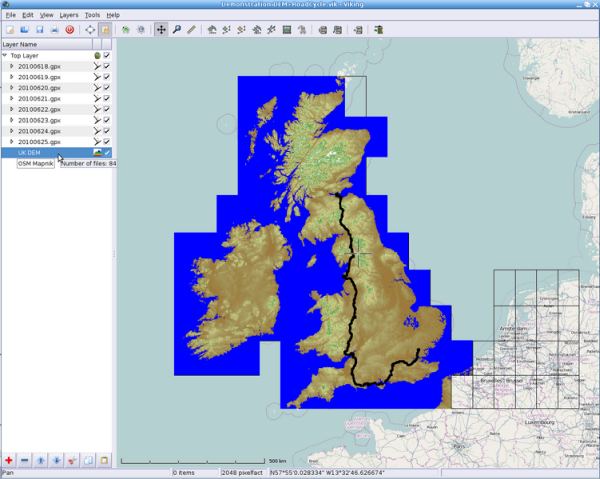Viking aims to be an easy to use, yet powerful in accomplishing, a wide variety of GPS related tasks. It uses a hierarchical layering system to organize GPS data, maps, and other layer types with spatial data, such as coordinate lines.
With this software, users can import, plot and create tracks and waypoints, show OSM, Terraserver and other maps, see real-time GPS position, get geocaches, control items, etc.
It uses the GTK+ 3 toolkit.
Features include:
- Uploading and downloading waypoints, tracks to/from GPS.
- Realtime GPS tracking and track recording.
- Preparing tracks and waypoints for trips using maps from services such as Googlemaps, Terrasever. You only need to upload the data to your GPS before you leave. The maps together with your tracks and waypoints can also be printed and used during the trip.
- After trips, tracks and waypoints from GPS can be downloaded, stored, managed and reused in later trips.
- Analyzing OHV and hiking trips, understanding where you went and how far you were from something.
- Making waypoints and tracks to follow to easily get some place you have not been to or do not have GPS data for but Terraserver maps exist for it.
- Making maps with coordinate lines.
- Analyzing speed at different places, adding waypoints where you forgot to mark one but did slow down or stop.
- Grouping data from multiple trips using a hierarchical data manager.
- Show the live GPS position on the map (for use on a mobile device – e.g. a laptop).
- Layers supported:
- Aggregate – a container layer to hold other layers. This layer type is useful for grouping other layers, especially TrackWaypoint layers.
- TrackWaypoint – displays GPS data (tracks and waypoints).
- GPS – responsible for uploading and downloading GPS data from a GPS device. It also is responsible for realtime GPS tracking.
- DEM – provides elevation data from the Shuttle Radar Topography Mission (SRTM).
- Coord – allows drawing of grid lines on the viewport.
- GeoRef – allows users to use any image as a map.
- Maps – provides a single map resource, you may have multiple map layers but only top one (if enabled) will be visible. Inbuilt maps include:
- Terraserver Topos.
- Terraserver Aerials.
- Terraserver Urban Areas.
- OpenStreetMap (Osmarender).
- OpenStreetMap (Mapnik).
- OpenStreetMap (Maplint).
- OpenStreetMap (Cycle).
- NASA BlueMarble.
- SpotMap (Viking Version1.1+).
- Supports a wide variety of map types including WMS, OSM, TMS, SPOTMaps.
- Support for Locosys and DeLorme GPS devices.
- Internationalization support.
Website: sourceforge.net/projects/viking
Support: GitHub Code Repository
Developer: Evan Battaglia and contributors
License: GNU General Public License v2.0

Viking is written in C. Learn C with our recommended free books and free tutorials.
| Popular series | |
|---|---|
| The largest compilation of the best free and open source software in the universe. Each article is supplied with a legendary ratings chart helping you to make informed decisions. | |
| Hundreds of in-depth reviews offering our unbiased and expert opinion on software. We offer helpful and impartial information. | |
| The Big List of Active Linux Distros is a large compilation of actively developed Linux distributions. | |
| Replace proprietary software with open source alternatives: Google, Microsoft, Apple, Adobe, IBM, Autodesk, Oracle, Atlassian, Corel, Cisco, Intuit, SAS, Progress, Salesforce, and Citrix | |
| Awesome Free Linux Games Tools showcases a series of tools that making gaming on Linux a more pleasurable experience. This is a new series. | |
| Machine Learning explores practical applications of machine learning and deep learning from a Linux perspective. We've written reviews of more than 40 self-hosted apps. All are free and open source. | |
| New to Linux? Read our Linux for Starters series. We start right at the basics and teach you everything you need to know to get started with Linux. | |
| Alternatives to popular CLI tools showcases essential tools that are modern replacements for core Linux utilities. | |
| Essential Linux system tools focuses on small, indispensable utilities, useful for system administrators as well as regular users. | |
| Linux utilities to maximise your productivity. Small, indispensable tools, useful for anyone running a Linux machine. | |
| Surveys popular streaming services from a Linux perspective: Amazon Music Unlimited, Myuzi, Spotify, Deezer, Tidal. | |
| Saving Money with Linux looks at how you can reduce your energy bills running Linux. | |
| Home computers became commonplace in the 1980s. Emulate home computers including the Commodore 64, Amiga, Atari ST, ZX81, Amstrad CPC, and ZX Spectrum. | |
| Now and Then examines how promising open source software fared over the years. It can be a bumpy ride. | |
| Linux at Home looks at a range of home activities where Linux can play its part, making the most of our time at home, keeping active and engaged. | |
| Linux Candy reveals the lighter side of Linux. Have some fun and escape from the daily drudgery. | |
| Getting Started with Docker helps you master Docker, a set of platform as a service products that delivers software in packages called containers. | |
| Best Free Android Apps. We showcase free Android apps that are definitely worth downloading. There's a strict eligibility criteria for inclusion in this series. | |
| These best free books accelerate your learning of every programming language. Learn a new language today! | |
| These free tutorials offer the perfect tonic to our free programming books series. | |
| Linux Around The World showcases usergroups that are relevant to Linux enthusiasts. Great ways to meet up with fellow enthusiasts. | |
| Stars and Stripes is an occasional series looking at the impact of Linux in the USA. | |

Does this work on Raspberry Pi 3 Buster?, I tried the “Snap” version, no Icon, so I cannot activate it,